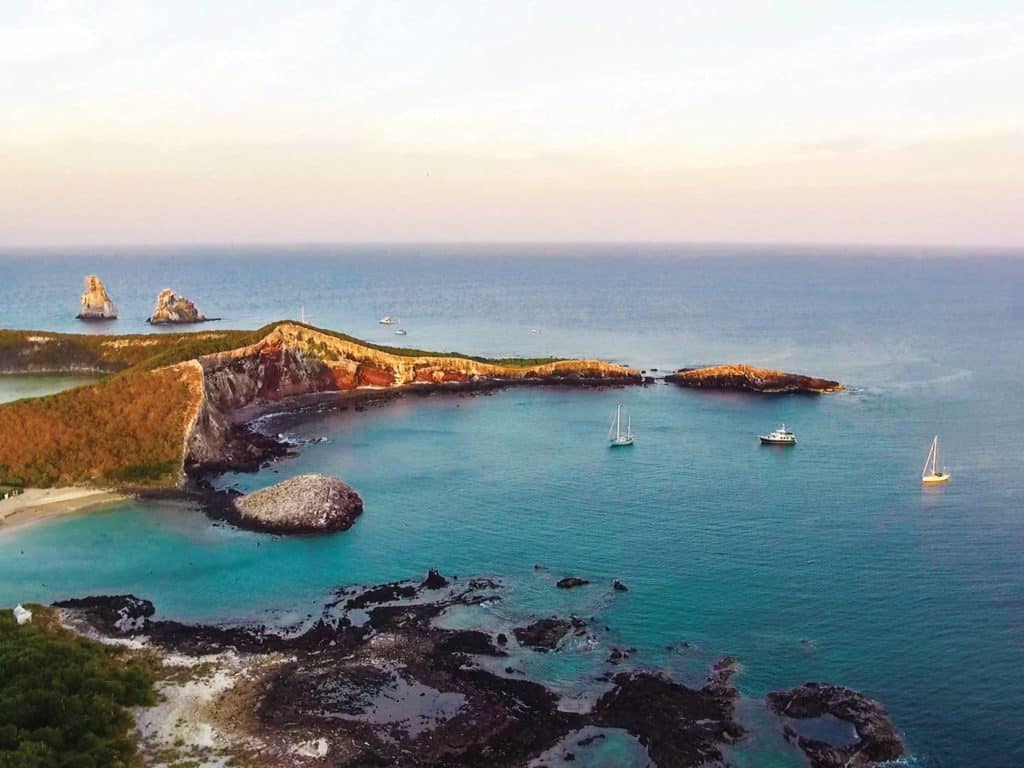
Stowing the hatch boards is a good sign. At home when you head off into the wilderness, you typically lock up your house nice and tight before saying adios. On the boat we take the house with us, so instead of locking up, we throw things open. Especially when our adventures involve sailing the enclosure-optional, comfortable climes of Mexico. And so I was smiling as I pulled our varnished teak weatherboards and tucked them away down below. I peered up at the cockpit through the now wide-open companionway. Who needs doors when your neighbors are deep ocean swells, tall starry nights or broad empty coasts?
It was January, and the Mazatlán marina where we had berthed to celebrate the holidays with our family was falling astern. After a month, my partner, Greg, and I were eager to return to cruising and be back on our way in this shiny, still-in-the-package new year. We threaded Dogfish, a 1977 Kelly Peterson 44, through the narrow, surging, shallow channel towards the open Pacific, closely following our incoming track. I watched our depth sounder tick down: 3 feet, 1 foot, -.1 foot. Now facing the Pacific swell, the surge pushed us close to the rocks. Greg throttled up as a wave gave us a few more feet under our keel, and we heaved past the worst of it.
“Thank God that’s the last time we have to do that,” he said with relief.
“On to Isla Isabela!” I responded.
The sunlight was long and warm as we set our bow west to clear two inshore islands before raising sail, easing sheets and settling into an easy run. As the sun sank lower, the world turned soft and orange. Gliding over the flat water I felt like we were sailing on a romantic candlelit tabletop. I turned my head to the sunset in time to see the last wisps of a splash on the horizon. “Greg, a whale!” He turned to look, and as we gazed west, a second large humpback whale breached almost completely out of the water, sending splashes into the air, leaving water spots on the setting sun and dropping two jaws that were not in the habit of coming unhinged. Sailing 2018 was starting off beautifully.
The new year for me is often equal parts exciting and maddening. It stands before me like a giant blank slate, resting in a deep rut. The resolutions of January have always felt to me like zephyrs that leave me bobbing on a millpond by the time opening day swings around. Why this is the case is no mystery to me. When I hold up a brand-new calendar I am under no illusions that this assemblage of paper grids has the power to overcome the inertia of a life already barreling away under full canvas. As a sailor I know what’s required to change course and tack: the momentum, the willingness to throw the helm, the fortitude to dig in and rebuild speed. The calendar, this paper book of months, doesn’t have it. When I hold it up to the wind, it just flutters.
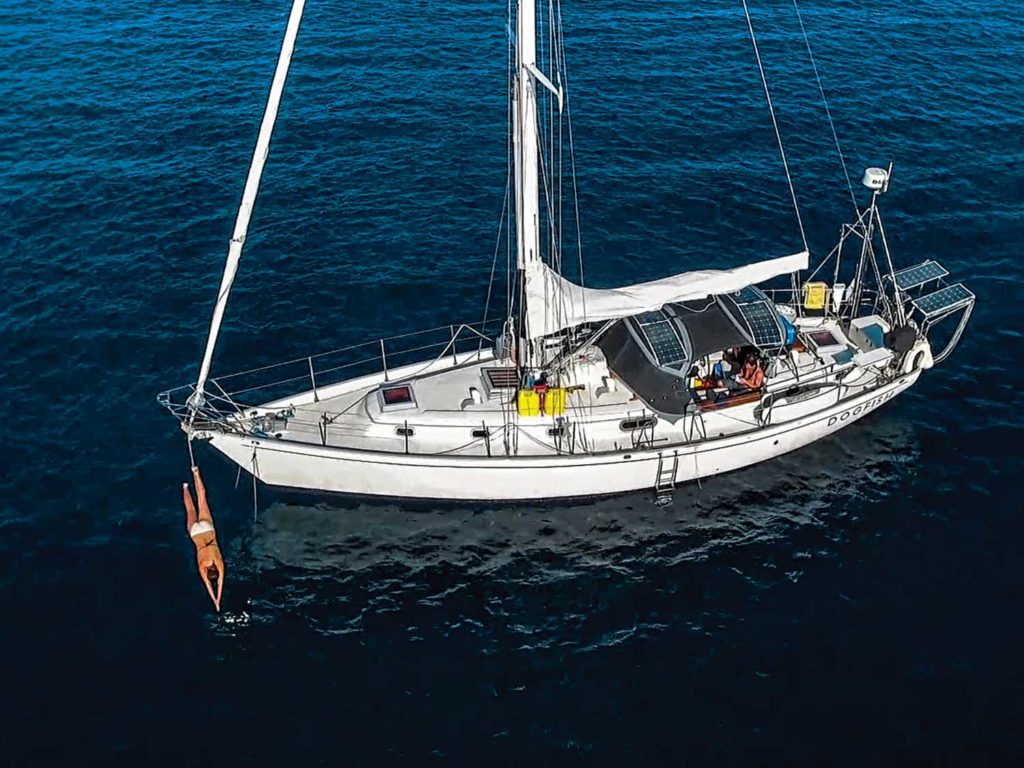
And as a cruising sailor what change could I be aiming for, anyway? Wasn’t I kind of living the dream already? I was reminded of Greg’s mom. When she heard we planned to cruise indefinitely and were now expanding our monthly budget to include things like retirement savings, she exclaimed, “Retirement? Retire from what?”
Which is a completely reasonable response. We have understood that as our latitudes have dropped, so has the level of sympathy we get when we are talking to people back home. People who are dealing with things like traffic, angry bosses or winter. What real change could we possibly need — dark rum to white? There doesn’t seem to be good reception for problems when transmitting from paradise.
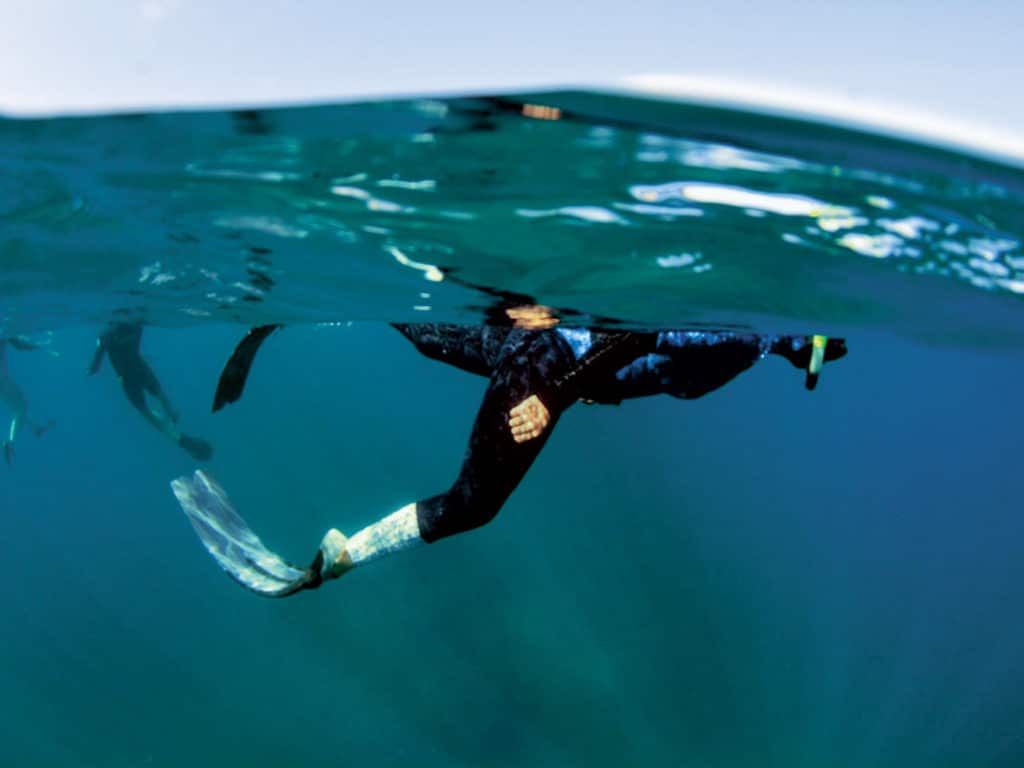
When I got up for my night watch, it seemed to me that the world had disappeared. We were sailing in a void, with a black sky above and a black sea below. The dark was blinding and consuming. The only remnant of the day to survive in the opaque night was the steady low hum of the mid-teens wind, this small thread connecting the world we had known to the one we hoped dawn would bring again. We were swept along as though on a jackline, pulling us southward, hoping it was enough to keep us tethered through this space odyssey.
The breeze was steady, and our course was straight. I checked the radar and AIS returns and watched as our little red boat moved down our long red rhumb line on the computer screen. We were making good progress. I sat down in the cockpit and picked up my book to read, but my thoughts kept wandering. I gave up and stared into the nothing beyond Dogfish‘s decks. I let the void lure me in, my thoughts wandering out across the invisible swells.
We were sailing in a void, with a black sky above and a black sea below. The dark was blinding and consuming.
On Dogfish, we love heaving-to. The contrast between the energy-filled moments before backing the jib and the rhythmic calm right after is stark. The just-passed holiday season had felt like this to me. One day we tied into a marina, the first in months, and the next day we awoke in fluffy king beds with fresh sheets, ensconced in Airbnbs in the quaint parts of lovely Mexican towns. We were surrounded by the people we know and love best, with produce we didn’t have to mete out, water we didn’t have to test with a salinity probe and ice cubes we didn’t have to feign friendships for. The previous months spent in our ascetic and rugged cruising life felt like a hallucination.
It was energizing and soul filling to see our families again, but it was not without some realizations for us. After our first year of sailing, being close again meant the gaps that cruising had notched between us and those from whom we sailed away now lay unmistakably at our feet. Despite our efforts to keep in touch, our separate lives felt a million miles apart. We did our best to catch up to all the changes in their lives, but still felt strangely removed. “So how is … Alex? That’s your new boyfriend’s name, right? And what about the new job? I guess it’s actually not so new anymore, is it?”
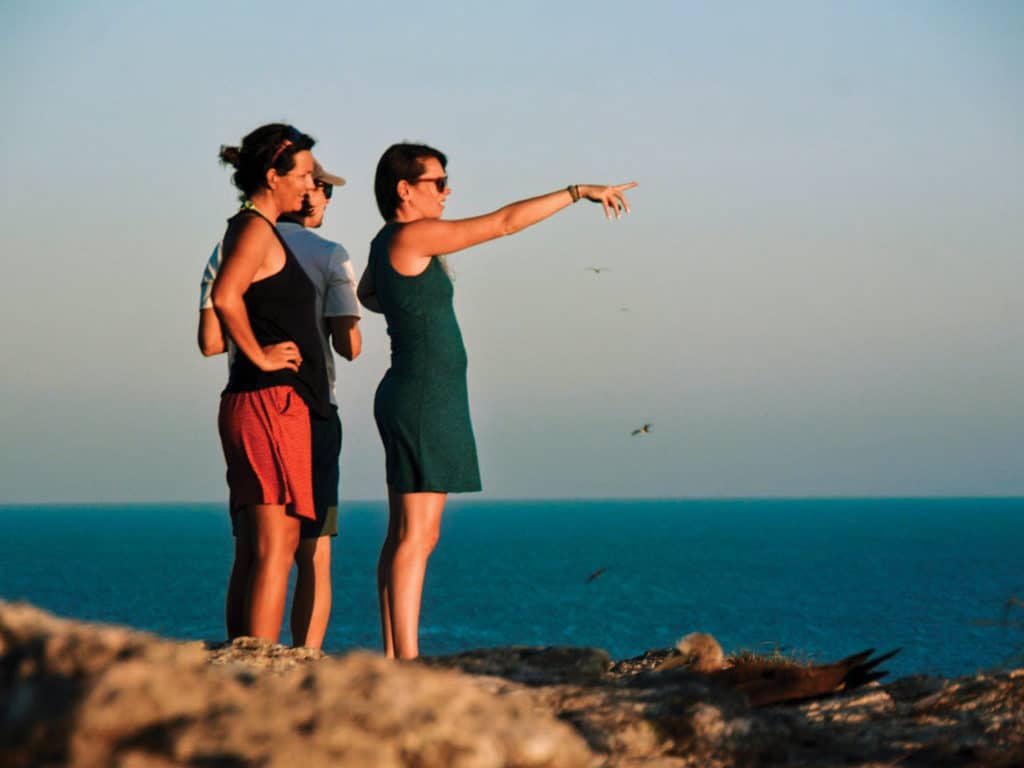
Greg and I, in turn, were a challenge to find. We no longer had the usual markers — updates with our jobs, our friends, our neighborhood — all the cairns that we normally use to understand the lay of someone else’s life. And we couldn’t find the right words for what things were really like for us now, to relate our victories or our challenges. We struggled to convey the reality of this new life that was neither Jimmy Buffet songs nor Patrick O’Brian novels.
And so we all sipped margaritas, one big family again, around one big table again, all of us trying our best to bridge the gaps and reach each other, pretending that it still felt the same. And before we knew it, it was over. The new year rang in, and soon there were tears and goodbyes as airport taxis came and rental apartments were given a final once-over. Greg and I found ourselves back on Dogfish, with things seemingly the same except that our pants were a little tighter and moods a little heavier. We blew the jib and fell out of the heave-to, returning to our boat-life rhythm, preparing to sail on. The winds were the same, but the crew felt different.
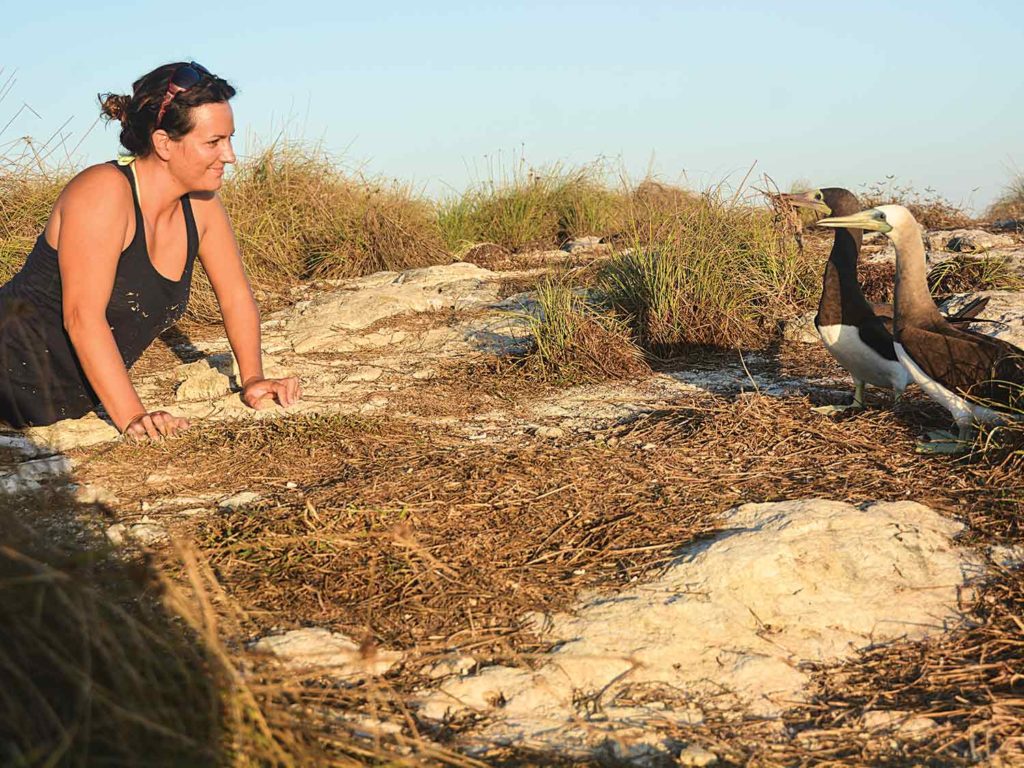
The night’s tether worked and delivered us into pre-dawn light. My weary eyes watched the black collapse to gray, and shortly after dawn, Isla Isabela’s small form appeared on the horizon. Here was an island that understood change. She jutted up defiantly from the water, her proud and swooping cliffs veiling the fact that behind the armaments was a deep crater, a now-gutted volcanic peak that had blown up and bowled out the heart of this island, spewing the morphed remains over the hillsides and shores.
Here was a lady who knew how to adapt. So what if you suddenly find yourself a blown-out, insides-outside, top-lopped-off, barren black volcano rock, the only land in sight, encircled by a sea eager to eat away at your rubble? Fill your old crater with fresh water, make a lake. Grow grasses to cover your bare hillsides. Invite ground-nesting boobies — those otherwise svelte birds with feet three sizes too big to be believable — to cover your slopes with their waddling forms.
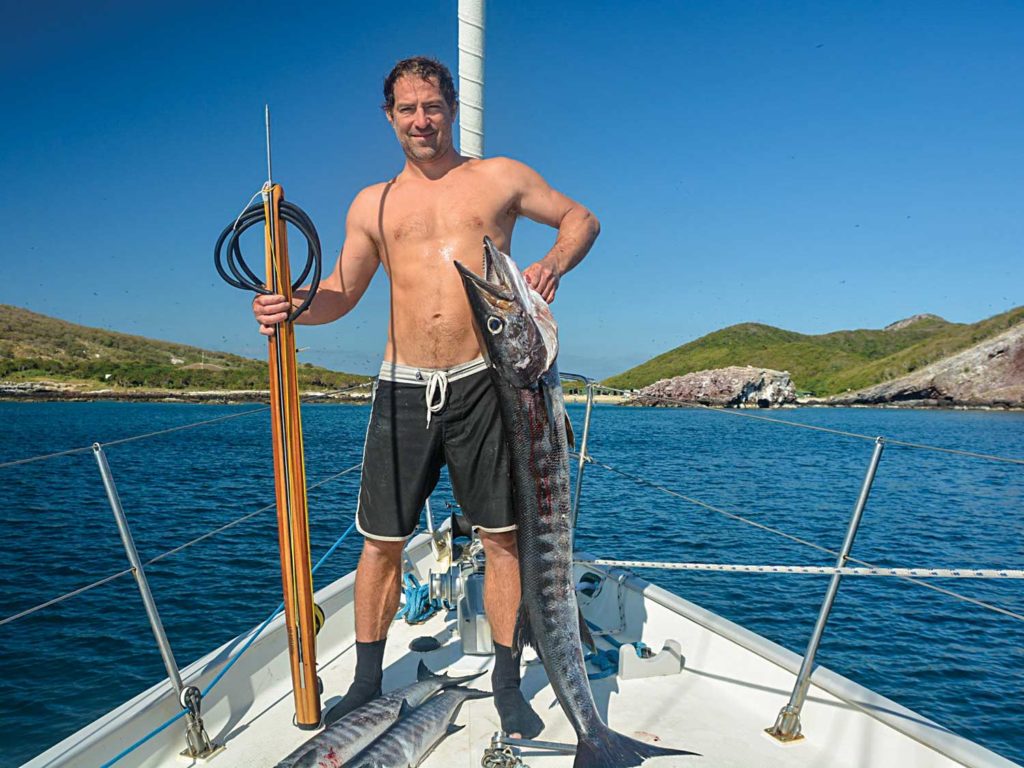
When you run out of real estate, vertically integrate with a thick pygmy-tree forest. Then more birds — nesting frigates — will call the treetops home, their squawks from above harmonizing with boobie whistles from below. Add pelicans because no self-respecting sea island leaves out the pelicans. Contract iguanas to street sweep unrealized eggs. Bring tiny red milk snakes to feed on the leftovers, and add large termite colonies because everyone knows they’re going to show up, invited or not. Barren will be a faint memory because once life grabs ahold, it inserts itself into every crevice and breath. Given the tiniest chance, it wins every time — even on a volcanic rock in the middle of the ocean.
The sun was firmly entrenched by the time we motored into the small rock-strewn harbor of Isabela. Greg dove in with snorkel and fins to search for a good sandy spot where we could drop anchor. On his way back, he poked his head up to exclaim, “The whales! You can hear their calls underwater!”
While hurrying through all the small chores of putting the boat away, we kept taking distracted looks around us, in awe to now be hanging off the side of this sweeping and overstuffed refuge of a rock surrounded by blue ocean. Birds flew in swarms overhead, schools of fish darted below us, and on the horizon, whales surfaced and breached. The exhaustion of our night passage was completely forgotten. We dropped the dinghy in the water, threw in our free-diving gear and set off on a perimeter tour.
After eight months in Mexico, I had spent many hours snorkeling in some amazing spots, but when we dropped into a school of bigeye trevally on the north side of the island, I cried into my mask for the first time.
I say it was a “school” because that’s what my head says, but this looked more like chaotic recess to me. It was a tangle of trevally. The fish were coming straight at me; they were swimming straight down to where Greg was holding his breath, watching from the seafloor. They were swimming in great ribbons over the bottom, mimicking the contours and overlapping with themselves. They were swimming back up again in a vertical stream.
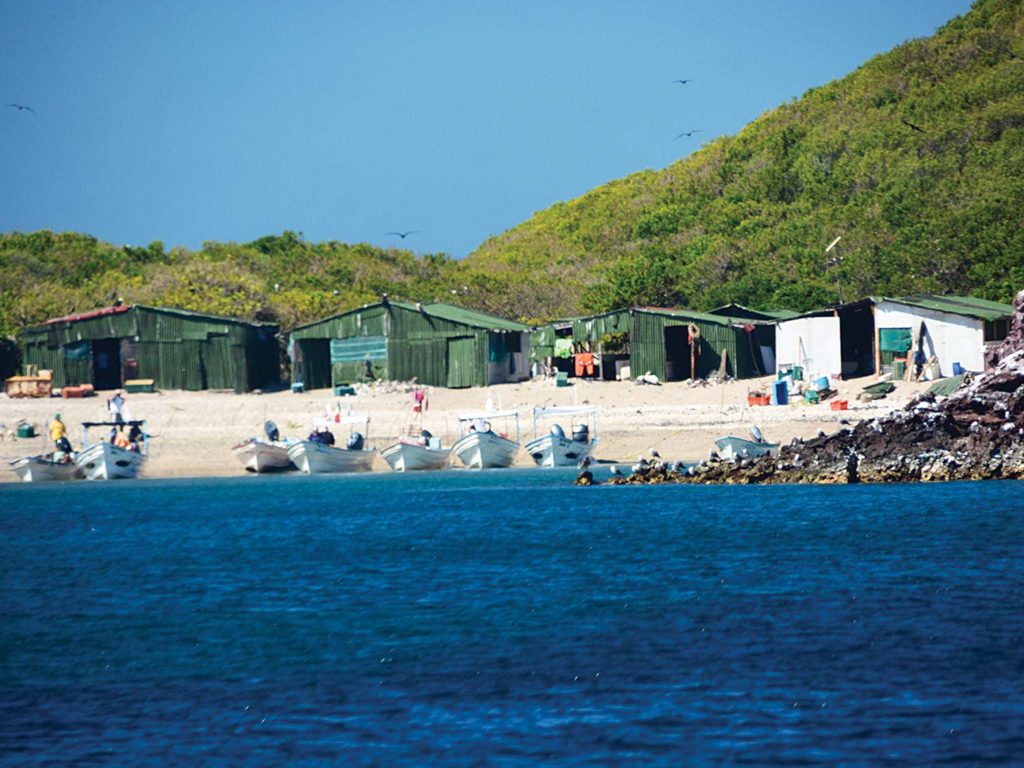
It was like snorkeling in a giant loom, with thousands of shiny bodies weaving their own roving safety blanket. It pulsed with silver and flashed when the sun caught a tail or a belly; it surged with the swell and was never the same twice. Smaller surgeon fish, sergeant majors and even a sea turtle snuck in for a small respite. Such a display of life, enveloping me while also paying me no notice, made me feel so happily insignificant. The downside to crying in your mask is that it tends to fog up. The blanket faded into a foggy blur until I finally submitted and tore my head out of the water to fix my gear.
Sitting on the side of the dinghy, adjusting my mask, Greg swam up with more news. “There’s wahoo here!” he gurgled while dropping his snorkel. “I can’t believe it, hand me my gun!” I had barely handed Greg his wooden spear gun before he was kicking out to the trevally school again. Within half an hour Greg had speared three, including a monster 25-pounder and two smaller ones he got with a single shot.
Such a display of life, enveloping me while also paying me no notice, made me feel so happily insignificant.
We motored back round to Dogfish to fillet and vacuum bag the catch. I was already greedily planning the sushi platters, poke bowls and seared steaks that lay in our future. After a quick shower, we made a snack of smoked fish, cheese and crackers and sat in the cockpit under a warm sun in the early afternoon. Before we could mount a defense, the night passage caught up with us, and we fell asleep just as we were, snacks still on the table, collapsed in our cockpit chairs — dead to the world, smiles on our lips.
RELATED: Sailing to Mexico with the Baja Ha-Ha
The sun rose at Isla Isabela over the swooping cliff faces on the east side of the anchorage, light streaming in through the open hatch above our berth. I rose and met Greg, who already had his coffee made, to greet the day from the deck. Over breakfast we watched as the baby blue ketch of our friends on Small World came into view. We dinghied out to meet them.
“This place is ridiculous!” said Craig after they were anchored. Krystle sent a big, “Helllooooo!” from the bow, along with a wide white smile. Seeing them again was refueling. It had been so long since we had spent time with young friends our own age, with people we weren’t meeting for the first time and who were also cruising.
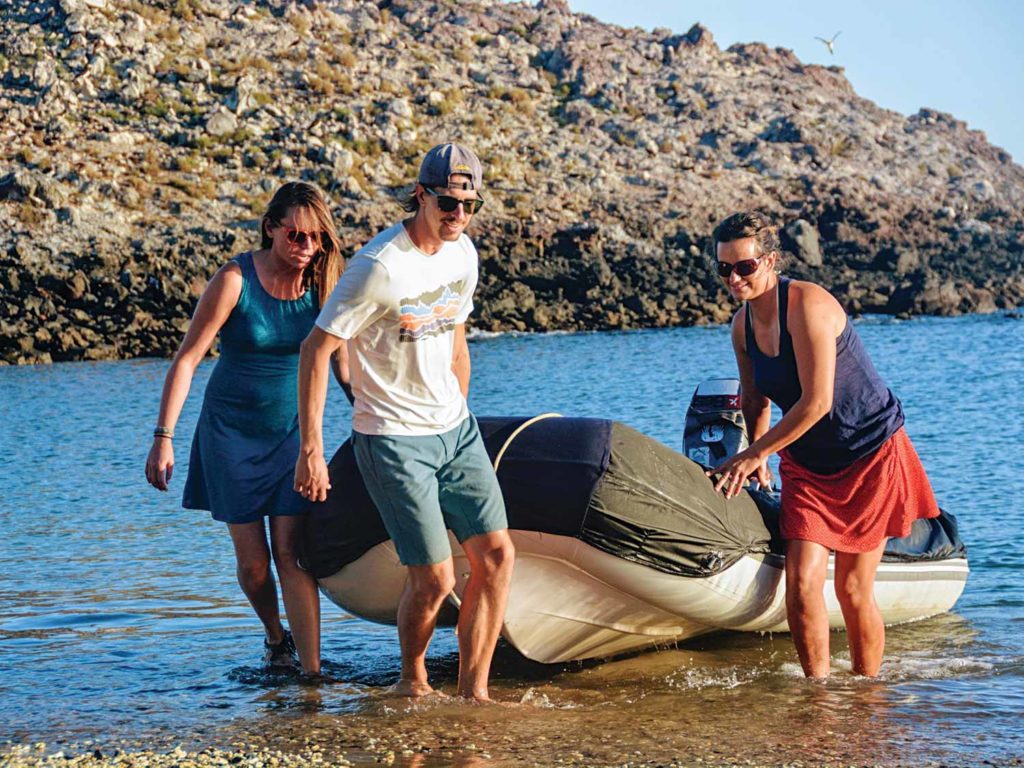
After they had rested, we all landed the dinghy on the beach near the fish camp. Pulling on backpacks stuffed with cameras, beers and sunset appetizers, we set out for a hike. We were excited to take in the wildlife, especially the birds, which we had read were comfortable with humans approaching very close, as they faced no natural predators on the island. Craig, who we occasionally dubbed Cousteau because of his tall, thin frame and love of all things of the sea, could hardly contain his excitement. He had yearned to see blue-footed boobies before he and Krystle had even started cruising.
Isla Isabela had been a favorite of Jacques Cousteau, and after hiking to the top of the cliffs on the west side of the island, Craig “Cousteau” seconded his approval. We were in the middle of a wide booby party, and they paid us no heed. There were boobies nesting eggs, looking to find a mate, even a mother sitting on top of a newly hatched booby, whose small face occasionally poked out from under a wing.
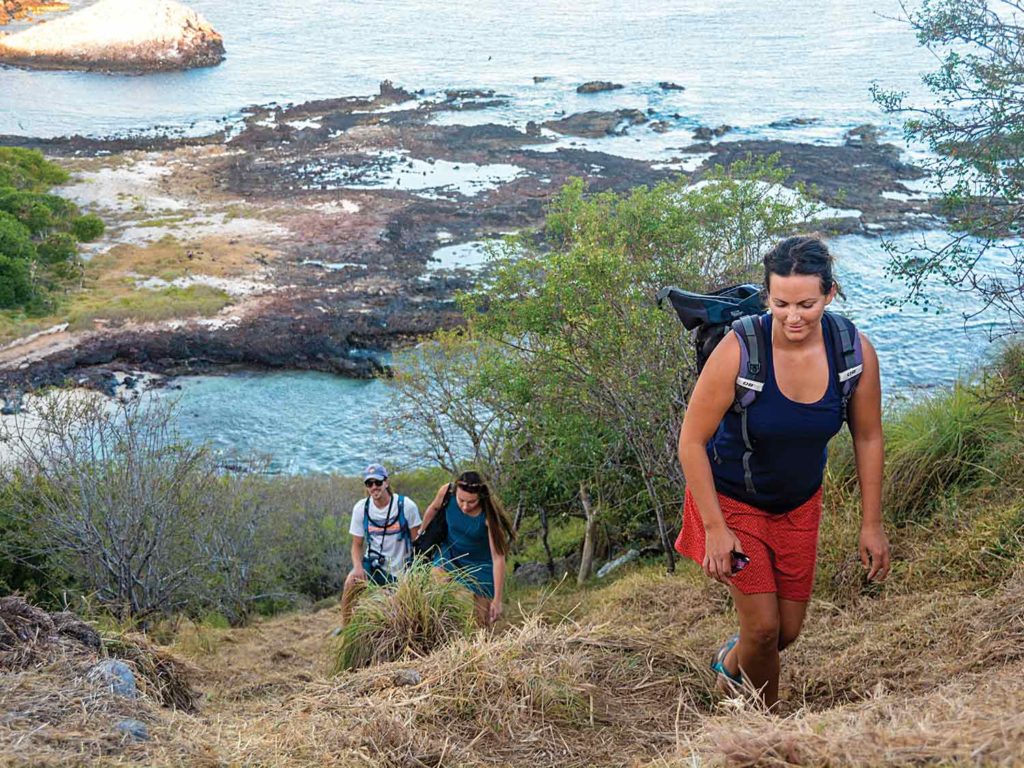
We got on the ground at bird height; they looked at us, we at them, just a few feet apart. We carefully stepped out of the way of boobies in the midst of their two-stepping mating dance. We watched others take off, soaring off the guano-speckled cliffs. The transformation from waddling clown to elegant flyer was astonishing. Then we watched them land, the whole transformation running backwards as they redeployed their massive blue landing gear. Craig lay with his stomach on the ground, close to the action. Krystle started narrowing in on individual birds, offering witty narrations for them in a faux British accent.
We watched the sunset from the top of the cliff. Perched on the guano rocks, we ate and drank beers. Our chatting and squawking grew louder as those of the boobies receded in the night. Our faces caught the last of the sun’s light as we sat in a row, four bodies on the edge of the volcanic rock, carrying on, full and alive, while the endless Pacific stretched below us like a blue abyss.
I thought of Isabela again, that even this island’s abundance of life did not happen in a vacuum. One of the reasons the island is such an important bird rookery is that only 15 or so miles away on the mainland lies one of the most important marshlands on the Pacific-Mexico Coast. It is the exchange between these two places that make each of them so vibrant; they are connected, sustained and enhanced by the life they each support, by the life that passes between them.
Over the next few days, we ate our hearts out taking the island in. We said hello to the fishermen who set out from their camp every morning, seeking the day’s catch. We hiked over and across the island, going up and down her steep sides on small paths cut into the pygmy forest. We reached the crater lake. The first vision of that thick, coolant-green water was enough to cut down any swimming aspirations Krystle had entertained.
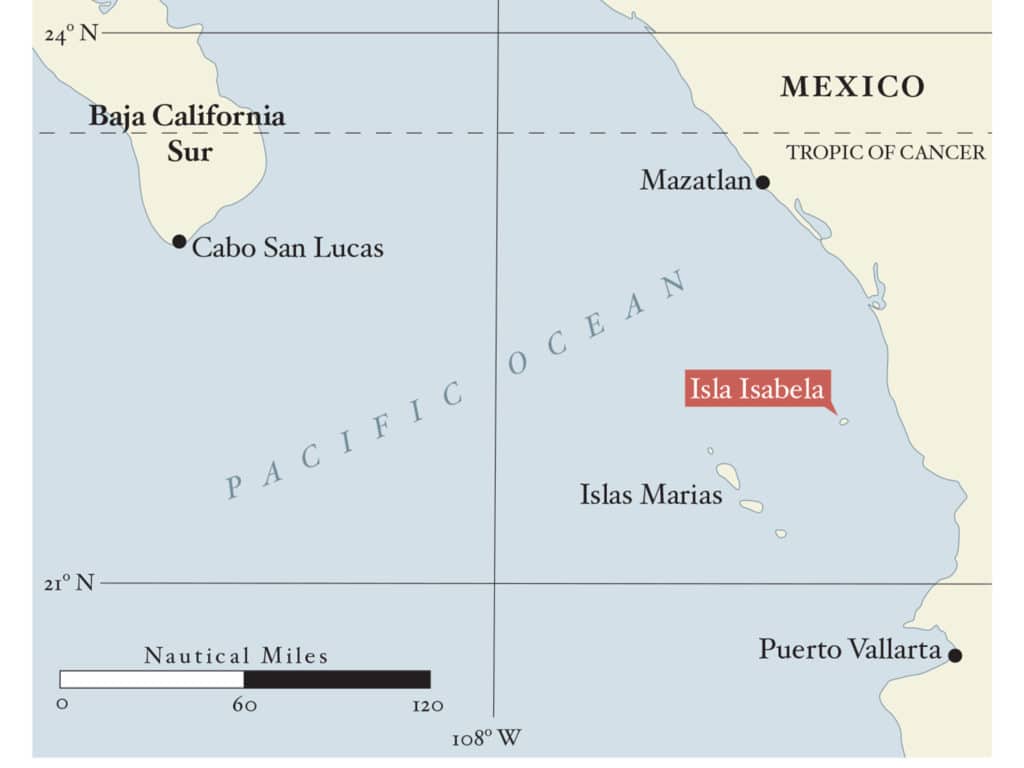
We brought cameras and spent hours taking pictures of whatever struck our fancy: spiders building large webs across the trail, dead frigate birds whose feathery skeletons hung from the branches of the trees. We tailed small snakes and searched for iguanas and lizards. We peered under shoreline rocks between waves to watch crabs. We set our eyes on the horizon to see whale spouts and splashes, expressing mock frustration when multiple whales made a show in several different directions — it was impossible to take it all in.
In the dinghy, we braved the rough waters on the unprotected north side of the island, seeking out whales up close. We surfed through the whitewater in between outlying rocks and anchored the tender in water bubbling with fish. We dove and snorkeled with sea turtles and large schools. Greg had to give up spearfishing temporarily; our stores were now bulging from his successes.
Dates were forgotten as we marched to the metronome of dawn and dusk, watching the sun rise over the ridge, set over the water.
One day brought a new excitement as we watched the anchorage slowly fill in with friends we hadn’t expected to see, as well as other cruisers we were excited to meet. By evening’s end, the harbor was teeming with the nomadic nests of migratory humans: Jody and Randy on Free Luff, Lance and Pam on Shamaya, Ed and Talica on Tioga, and even the crew and captain of the San Francisco charter catamaran Adventure Cat. It seemed birds weren’t the only ones flocking to Isla Isabela.
Upon seeing the situation — and with a refrigerator full of fish — we decided it was high time for a party. We made mountains of sushi rice and laid out the accoutrements. After sunset, the dinghies started arriving. People brought miso soup and poke, and we took turns making wahoo rolls and nigiri. We blended up pineapples with coconut cream and drank pina coladas. We made hibiscus margaritas and drank in the cockpit under the stars, voices and music spilling into the night. Late at night we set out on a game of dominoes with Krystle and Craig. It was well into the morning hours when we released the last dinghy painter from our stern, calling out a last goodbye before collapsing into bed.
We reveled in our island world. Our only link to the outside was a daily SSB weather check-in. Dates were forgotten as we marched to the metronome of dawn and dusk, watching the sun rise over the ridge, set over the water. The space between these two beats was everything. We found our lives and hearts filled to the brim, stuffed until overflowing like the pygmy forests we wandered through. The isolated island had given to us as the life clinging to her hillsides had given to her. It reminded us why we do this, why we commit to a cruising lifestyle, despite all the challenges it throws at us, and despite all the things it requires us to sacrifice.
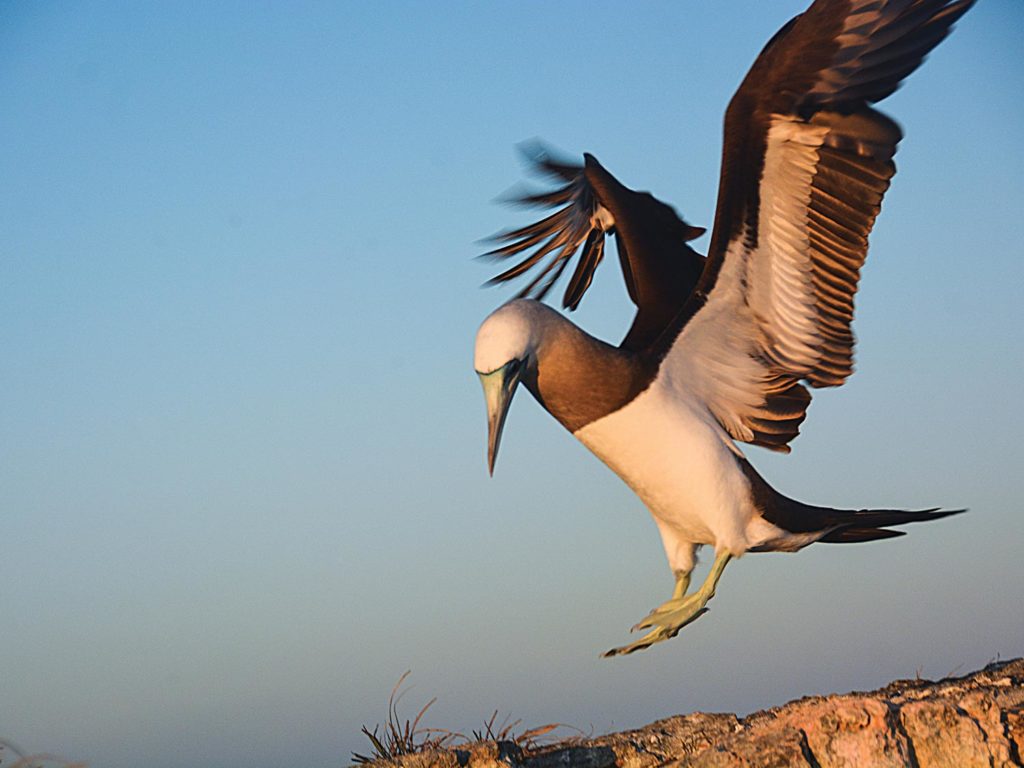
Isla Isabela chewed up the calendar, sending little grids of seven flying out into her updrafts, scattering them to the birds, perhaps to be used in a thousand nests filled with new life. A group consultation with Krystle and Craig, including a few disputed recounts, concluded that a full eight days had passed since we first clipped ourselves to these steep sides. It felt like we had just arrived. At the same time, the shiny new year looked like it had aged years. The 2018 that we had peered up at and considered now lay torn out of her package, scuffed up and covered in salt — just as we like it.
Only the first anchorage of the new year and already everything felt different. It was true that in our drifting life few things remained to hold on to, to anchor us in body or mind. But in exchange for letting go of being tied down, we were becoming woven in. By living in motion we were being incorporated into a new fabric, a pulsing one whose edges would extend as far as our imaginations would let us run. We maybe weren’t in close physical proximity to the people and places we once loved, but we were still connected by threads, fibers that now spooled out and spread far beyond us, connecting us to new people and places in ways we couldn’t have dreamed.
I thought back to our families. Maybe gaps had formed in beloved, established patterns. But perhaps this also meant new space had opened up where once everything had been filled to the brim. We could find new ways of connecting — sharing new adventures, meeting up in new locations instead of the old family house. Maybe the Mazatlán family trip had actually already been a start in that new direction. Who could say what might grow on these new bare hillsides, when given the chance?
We watched boobies fly overhead, taking off from the cliff sides to who-knows-where. Although they seemed entrenched on Isabela, with their messes of nests and blue feet everywhere, they actually spent their lives at sea. They came to Isabela only as a stop, a place to build nests, meet a mate and create life once more. Isabela gave them this transfusion, and they returned the favor by supporting the life of the permanent island residents who grew, crawled and slithered on her sides. It was a life system connected and in motion, like the pulsing blanket of trevally had been on that first day diving.
We felt a faint breeze building, and our thoughts turned to the sea once more. An SSB weather forecast confirmed our suspicions of a beautiful wind coming. We prepared to get underway, and I stood at the bow to handle the windlass. On my right was Isla Isabela, on my left the Pacific horizon. I brought up the anchor, as if pulling a tailor’s pin that lets the fabric relax. We were adrift once more, possibility opening around us like gaps in a loose weave. We belonged everywhere and nowhere.
Marga Pretorius is a boatwright and cruiser exploring the Mexican coast with her partner, Greg O’Toole. You can follow their adventures at svdogfish.com.








